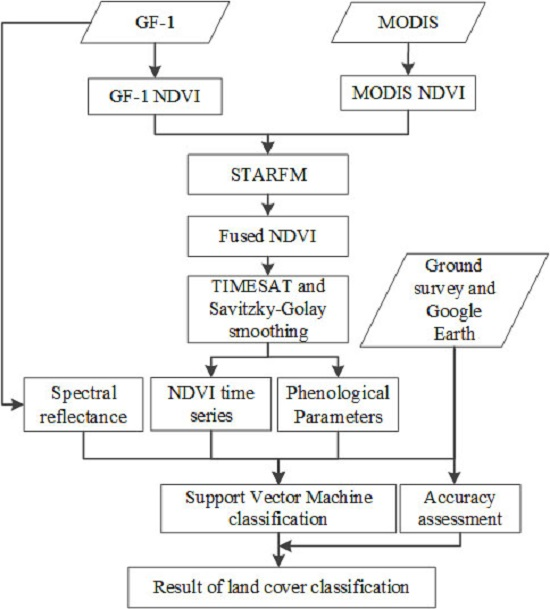Land Cover Classification Based on Fused Data from GF-1 and MODIS NDVI Time Series
Abstract
:1. Introduction
2. Study Area and Data
2.1. Study Area
2.2. GF-1 Data and Pre-Processing
2.3. MODIS NDVI Time-Series Data
2.4. Field Survey Data
3. Methods
3.1. General Technical Procedure
3.2. Spatial and Temporal Fusion of the GF-1 and MODIS NDVI Data
3.3. Extraction of Phenological Parameters from the Fused NDVI Time Series
3.4. Land Cover Classification and Accuracy Assessment
4. Results
4.1. Assessment of the STARFM Simulation
4.2. Phenological Analysis
4.3. Classification Results and Accuracy Assessment
5. Discussion
5.1. Limitation of STARFM Simulation
5.2. Phenological Parameters Extraction
5.3. Land Cover Classification
6. Conclusions
Acknowledgments
Author Contributions
Conflicts of Interest
References
- Turner, B.L., II; Lambin, E.F.; Reenberg, A. The emergence of land change science for global environmental change and sustainability. Proc. Natl. Acad. Soc. USA 2007, 104, 20666–20671. [Google Scholar] [CrossRef] [PubMed]
- Verburg, P.H.; van de Steeg, J.; Veldkamp, A.; Willemen, L. From land cover change to land function dynamics: A major challenge to improve land characterization. J. Environ. Manag. 2009, 90, 1327–1335. [Google Scholar] [CrossRef] [PubMed]
- Gómez, C.; White, J.C.; Wulder, M.A. Optical remotely sensed time series data for land cover classification: A review. ISPRS J. Photogramm. Remote Sens. 2016, 116, 55–72. [Google Scholar] [CrossRef]
- Zhao, Y.; Feng, D.; Yu, L.; Wang, X.; Chen, Y.; Bai, Y.; Hernández, H.J.; Galleguillos, M.; Estades, C.; Biging, G.S.; et al. Detailed dynamic land cover mapping of Chile: Accuracy improvement by integrating multi-temporal data. Remote Sens. Environ. 2016, 183, 170–185. [Google Scholar] [CrossRef]
- Shao, Y.; Lunetta, R.S.; Wheeler, B.; Iiames, J.S.; Campbell, J.B. An evaluation of time-series smoothing algorithms for land-cover classifications using MODIS-NDVI multi-temporal data. Remote Sens. Environ. 2016, 174, 258–265. [Google Scholar] [CrossRef]
- Zhang, X.; Sun, R.; Zhang, B.; Tong, Q. Land cover classification of the North China Plain using MODIS-EVI time series. ISPRS J. Photogramm. Remote Sens. 2008, 63, 476–484. [Google Scholar] [CrossRef]
- Zhou, F.; Zhang, A.; Townley-Smith, L. A data mining approach for evaluation of optimal time-series of MODIS data for land cover mapping at a regional level. ISPRS J. Photogramm. Remote Sens. 2013, 84, 114–129. [Google Scholar] [CrossRef]
- Bradley, B.A.; Jacob, R.W.; Hermance, J.F.; Mustard, J.F. A curve fitting procedure to derive inter-annual phenologies from time-series of noisy satellite NDVI data. Remote Sens. Environ. 2007, 106, 137–145. [Google Scholar] [CrossRef]
- Tucker, C.J.; Sellers, P.J. Satellite remote sensing of primary production. Int. J. Remote Sens. 1986, 7. [Google Scholar] [CrossRef]
- Gevaert, C.M.; García-Haro, F.J. A comparison of STARFM and an unmixing-based algorithm for Landsat and MODIS data fusion. Remote Sens. Environ. 2015, 156, 34–44. [Google Scholar] [CrossRef]
- Busetto, L.; Meroni, M.; Colombo, R. Combining medium and coarse spatial resolution satellite data to improve the estimation of sub-pixel NDVI time series. Remote Sens. Environ. 2008, 112, 118–131. [Google Scholar] [CrossRef]
- Liu, D.S.; Pu, R.L. Downscaling thermal infrared radiance for subpixel land surface temperature retrieval. Sensors 2008, 8, 2695–2706. [Google Scholar] [CrossRef]
- Gao, F.; Masek, J.; Schwaller, M.; Hall, F. On the blending of the Landsat and MODIS surface reflectance: Predicting daily Landsat surface reflectance. IEEE Trans. Geosci. Remote Sens. 2006, 44, 2207–2218. [Google Scholar]
- Zhu, X.L.; Chen, J.; Gao, F.; Chen, X.H.; Masek, J.G. An enhanced spatial and temporal adaptive reflectance fusion model for complex heterogeneous regions. Remote Sens. Environ. 2010, 114, 2610–2623. [Google Scholar] [CrossRef]
- Hilker, T.; Wulder, M.A.; Coops, N.C.; Linke, J.; McDermid, G.; Masek, J.G.; Gao, F.; White, J.C. A new data fusion model for high spatial and temporal-resolution mapping of forest disturbance based on Landsat and MODIS. Remote Sens. Environ. 2009, 113, 1613–1627. [Google Scholar] [CrossRef]
- Wu, M.; Niu, Z.; Wang, C.; Wu, C.; Wang, L. Use of MODIS and Landsat time series data to generate high-resolution temporal synthetic Landsat data using a spatial and temporal reflectance fusion model. J. Appl. Remote Sens. 2012, 6, 63501–63507. [Google Scholar]
- Walker, J.J.; de Beurs, K.M.; Wynne, R.H. Dryland vegetation phenology across an elevation gradient in Arizona, USA, investigated with fused MODIS and Landsat data. Remote Sens. Environ. 2014, 144, 85–97. [Google Scholar] [CrossRef]
- Liu, H.; Weng, Q.H. Enhancing temporal resolution of satellite imagery for public health studies: A case study of West Nile Virus outbreak in Los Angeles in 2007. Remote Sens. Environ. 2012, 117, 57–71. [Google Scholar] [CrossRef]
- Schmidt, M.; Lucas, R.; Bunting, P.; Verbesselt, J.; Armston, J. Multi-resolution time-series imagery for forest disturbance and regrowth monitoring in Queensland, Australia. Remote Sens. Environ. 2015, 158, 156–168. [Google Scholar] [CrossRef] [Green Version]
- Xin, Q.C.; Olofsson, P.; Zhu, Z.; Tan, B.; Woodcock, C.E. Toward near real-time monitoring of forest disturbance by fusion of MODIS and Landsat data. Remote Sens. Environ. 2013, 135, 234–247. [Google Scholar] [CrossRef]
- Zhang, J.; Feng, L.; Yao, F. Improved maize cultivated area estimation over a large scale combining MODIS–EVI time series data and crop phenological information. ISPRS J. Photogramm. Remote Sens. 2014, 94, 102–113. [Google Scholar] [CrossRef]
- Senf, C.; Leitão, P.J.; Pflugmacher, D.; van der Linden, S.; Hostert, P. Mapping land cover in complex Mediterranean landscapes using Landsat: Improved classification accuracies from integrating multi-seasonal and synthetic imagery. Remote Sens. Environ. 2015, 156, 527–536. [Google Scholar] [CrossRef]
- Cammalleri, C.; Anderson, M.C.; Gao, F.; Hain, C.R.; Kustas, W.P. Mapping daily evapotranspiration at field scales over rainfed and irrigated agricultural areas using remote sensing data fusion. Agric. For. Meteorol. 2014, 186, 1–11. [Google Scholar] [CrossRef]
- Gao, F.; Anderson, M.C.; Kustas, W.P.; Wang, Y.J. Simple method for retrieving leaf area index froLandsat using MODIS leaf area index products as reference. J. Appl. Remote Sens. 2012, 6, 063554. [Google Scholar]
- Zhang, B.; Zhang, L.; Xie, D.; Yin, X.; Liu, C.; Liu, G. Application of synthetic NDVI time series blended from Landsat and MODIS data for grassland biomass estimation. Remote Sens. 2016, 8, 10. [Google Scholar] [CrossRef]
- Singh, D. Generation and evaluation of gross primary productivity using Landsat data through blending with MODIS data. Int. J. Appl. Earth Obs. Geoinf. 2011, 13, 59–69. [Google Scholar] [CrossRef]
- Olexa, E.M.; Lawrence, R.L. Performance and effects of land cover type on synthetic surface reflectance data and NDVI estimates for assessment and monitoring of semi-arid rangeland. Int. J. Appl. Earth Obs. Geoinf. 2014, 30, 30–41. [Google Scholar] [CrossRef]
- Tian, F.; Wang, Y.J.; Fensholt, R. Mapping and evaluation of NDVI trends from synthetic time series obtained by blending Landsat and MODIS data around a coalfield on the Loess Plateau. Remote Sen. 2013, 5, 4255–4279. [Google Scholar] [CrossRef]
- Singh, D. Evaluation of long-term NDVI time series derived from Landsat data through blending with MODIS data. Atmosfera 2012, 25, 43–63. [Google Scholar]
- Viovy, N.; Arino, O.; Belward, A.S. The Best Index Slope Extraction (BISE): A method for reducing noise in NDVI time-series. Int. J. Remote Sens. 1992, 13, 1585–1590. [Google Scholar] [CrossRef]
- Verhoef, W.; van der Kamp, A.; Koelemeijer, R. Climate Indicators from Time Series of NDVI Images; National Aerospace Laboratory NLR: Amsterdam, The Netherlands, 2005. [Google Scholar]
- Jönsson, P.; Eklundh, L. TIMESAT—A program for analyzing time-series of satellite sensor data. Comput. Geosci. 2004, 30, 833–845. [Google Scholar] [CrossRef]
- Jönsson, A.M.; Eklundh, L.; Hellström, M.; Bärring, L.; Jönssonet, P. Annual changes in MODIS vegetation indices of Swedish coniferous forests in relation to snow dynamics and tree phenology. Remote Sens. Environ. 2010, 114, 2719–2730. [Google Scholar] [CrossRef]
- Pan, Z.; Huang, J.; Zhou, Q.; Wang, L.; Cheng, Y.; Zhang, H.; Blackburn, G.A.; Yan, J.; Liu, J. Mapping crop phenology using NDVI time-series derived from HJ-1 A/B data. Int. J. Appl. Earth Obs. Geoinf. 2015, 34, 188–197. [Google Scholar] [CrossRef]
- Chen, J.; Jönsson, P.; Tamura, M.; Gu, Z.; Matsushita, B.; Eklundh, L. A simple method for reconstructing a high-quality NDVI time-series data set based on the Savitzky-Golay filter. Remote Sens. Environ. 2004, 91, 332–344. [Google Scholar] [CrossRef]
- White, M.A.; Thornton, P.E.; Running, S.W. A continental phenology model for monitoring vegetation responses to interannual climatic variability. Glob. Biogeochem. Cycles 1997, 11, 217–234. [Google Scholar] [CrossRef]
- Zhang, X.; Friedl, M.A.; Schaaf, C.B.; Strahler, A.H.; Hodges, J. Monitoring vegetation phenology using MODIS. Remote Sens. Environ. 2003, 84, 471–475. [Google Scholar] [CrossRef]
- Schwartz, M.D.; Reed, B.C.; White, M.A. Assessing satellite-derived start-of-season measures in the conterminous USA. Int. J. Climatol. 2002, 22, 1793–1805. [Google Scholar] [CrossRef]
- Van Leeuwen, W.J.D. Monitoring the effects of forest restoration treatments on post-fire vegetation recovery with MODIS multitemporal data. Sensors 2008, 8, 2017–2042. [Google Scholar] [CrossRef]
- Jönsson, P.; Eklundh, L. Seasonality extraction by function fitting to time-series of satellite sensor data. IEEE Trans. Geosci. Remote Sens. 2002, 40, 1824–1832. [Google Scholar] [CrossRef]
- Hou, X.H.; Niu, Z.; Gao, S.; Huang, N. Monitoring vegetation phenology in farming-pastoral zone using SPOT-VGT NDVI data. Trans. Chin. Soc. Agric. Eng. 2013, 29, 142–150, (In Chinese with English abstract). [Google Scholar]
- Vapnik, V.N. The Nature of Statistical Learning Theory; Springer Verlag: New York, NY, USA, 2000. [Google Scholar]
- Sellami, L.; Abderrahim, K. Classification and statistical learning for detecting of switching time for switched linear systems. J. Innov. Digit. Ecosyst. 2015, 2, 13–19. [Google Scholar] [CrossRef]
- Srivastava, P.; Gupta, M.; Mukherjee, S. Mapping spatial distribution of pollutants in groundwater of a tropical area of India using remote sensing and GIS. Appl. Geomat. 2012, 4, 21–32. [Google Scholar] [CrossRef]
- Petropoulos, G.P.; Kontoes, C.; Keramitsoglou, I. Burnt Area Delineation from a uni-temporal perspective based on Landsat TM imagery classification using Support Vector Machines. Int. J. Appl. Earth Obs. Geoinf. 2011, 13, 70–80. [Google Scholar] [CrossRef]
- Huang, C.; Song, K.; Kim, S.; Townshend, J.R.G.; Davis, P.; Masek, J.G. Use of dark object concept and support vector machines to automate forest cover change analysis. Remote Sens. Environ. 2008, 112, 970–985. [Google Scholar] [CrossRef]
- Carrao, H.; Goncalves, P.; Caetano, M. Contribution of multispectral and multitemporal information from MODIS images to land cover classification. Remote Sens. Environ. 2008, 112, 986–997. [Google Scholar] [CrossRef]
- Exelis Visual Information Solutions. ENVI User’s Guide, ENVI User’s Manual, ITT Visual Information Solutions; Exelis Visual Information Solutions: Boulder, CO, USA, 2008. [Google Scholar]
- Foody, G.M. Status of land cover classification accuracy assessment. Remote Sens. Environ. 2002, 80, 185–201. [Google Scholar] [CrossRef]
- Wang, J.Y.; Li, X.S.; Fan, W.Y. Extracting vegetation phenology using HJ-CCD image of high and moderate resolution remote sensing data—A case study in upper stream of Miyun Reservoir. J. Northeast For. Univ. 2014, 42, 88–94, (In Chinese with English abstract). [Google Scholar]
- Walker, J.J.; de Beurs, K.M.; Wynne, R.H.; Gao, F. Evaluation of Landsat and MODIS data fusion products for analysis of dryland forest phenology. Remote Sens. Environ. 2012, 117, 381–393. [Google Scholar] [CrossRef]
- Sakamoto, T.; Van Nguyen, N.; Ohno, H.; Ishitsuka, N.; Yokozawa, M. Spatio–temporal distribution of rice phenology and cropping systems in the Mekong Delta with special reference to the seasonal water flow of the Mekong and Bassac rivers. Remote Sens. Environ. 2006, 100, 1–16. [Google Scholar] [CrossRef]
- Wu, W.; Yang, P.; Tang, H.; Zhou, Q.; Chen, Z.; Shibasaki, R. Characterizing spatial patterns of phenology in cropland of China based on remotely sensed data. Agric. Sci. Chin. 2010, 9, 101–112. [Google Scholar] [CrossRef]
- Hird, J.N.; McDermid, G.J. Noise reduction of NDVI time-series: An empirical comparison of selected techniques. Remote Sens. Environ. 2009, 113, 248–258. [Google Scholar] [CrossRef]
- Eklundh, L.; Jönsson, P. TIMESAT3.1 Software Manual; Lund University: Lund, Sweden, 2011. [Google Scholar]
- White, K.; Pontius, J.; Schaberg, P. Remote sensing of spring phenology in northeastern forests: A comparison of methods, field metrics and sources of uncertainty. Remote Sens. Environ. 2014, 148, 97–107. [Google Scholar] [CrossRef]
- Linderholm, H.W. Growing season changes in the last century. Agric. For. Meteorol. 2006, 137, 1–14. [Google Scholar] [CrossRef]
- Myneni, R.B.; Keeling, C.D.; Tucker, C.J.; Asrar, G.; Nemani, R.R. Increased plant growth in the northern high latitudes from 1981 to 1991. Nature 1997, 386, 698–702. [Google Scholar] [CrossRef]
- Zhou, L.; Tucker, C.J.; Kaufmann, R.K.; Slayback, D.; Shabanov, N.V.; Myneni, R.B. Variations in northern vegetation activity inferred from satellite data of vegetation index during 1981 to 1999. J. Geophys. Res. 2001, 106, 20069–20084. [Google Scholar] [CrossRef]
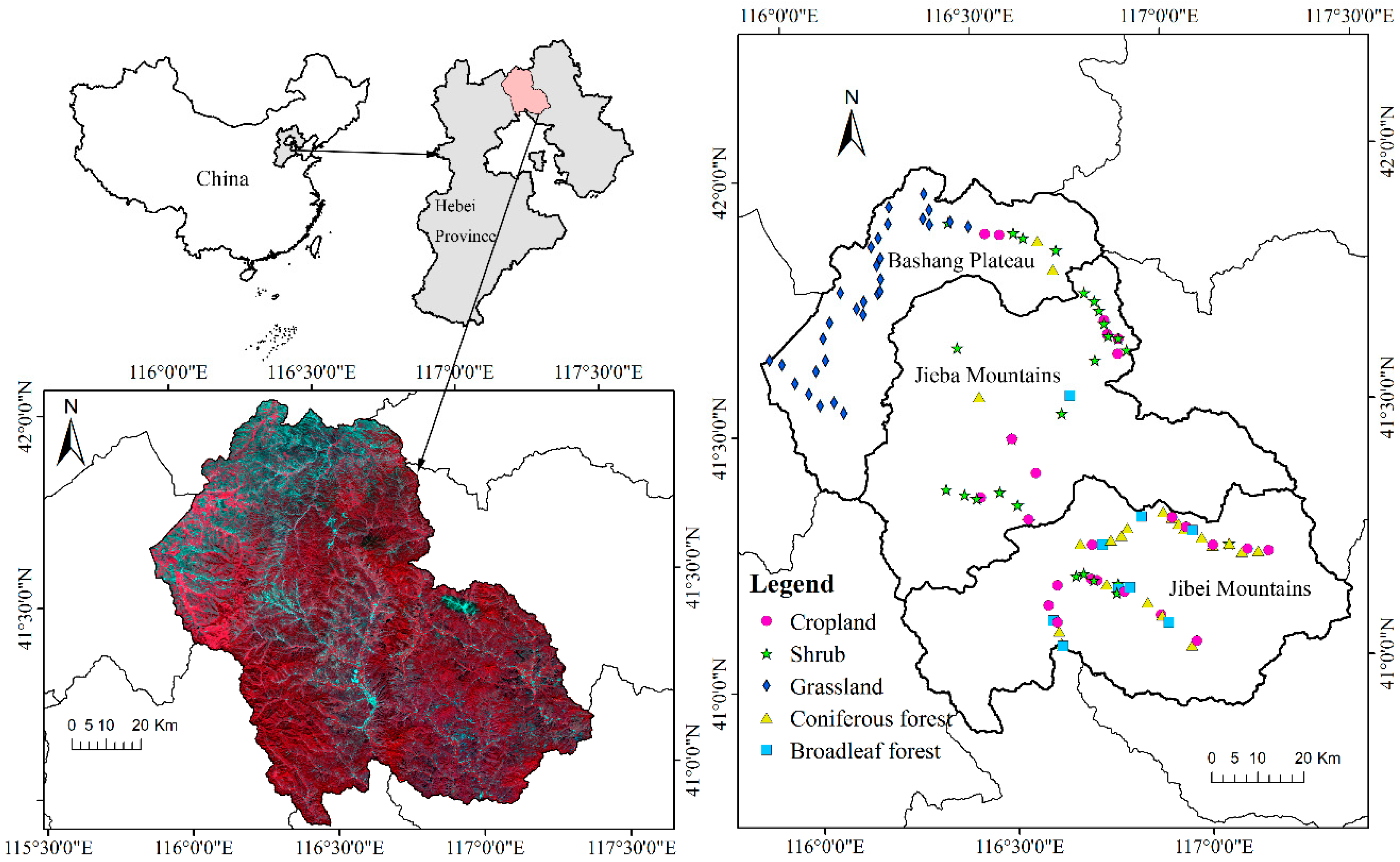

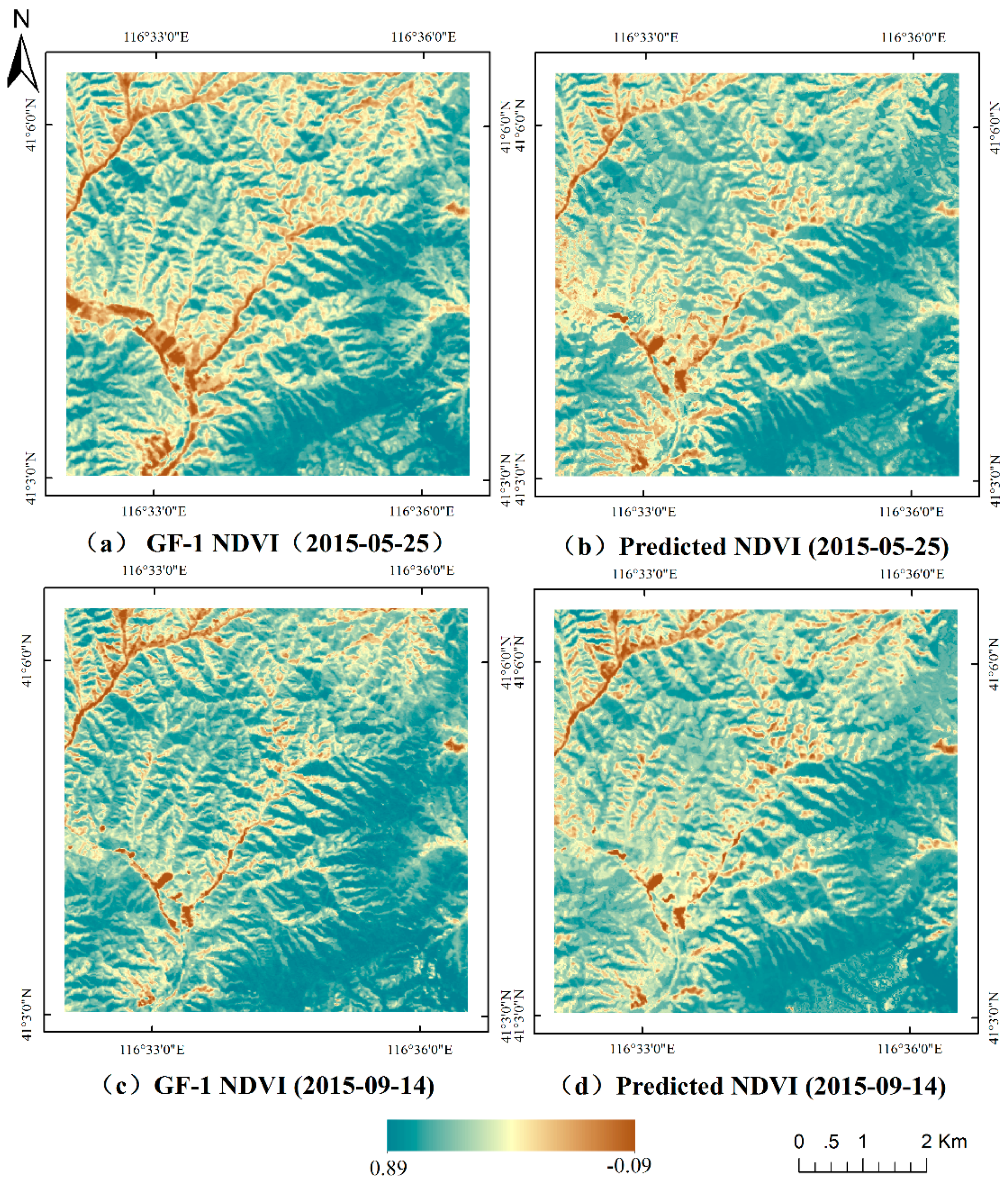

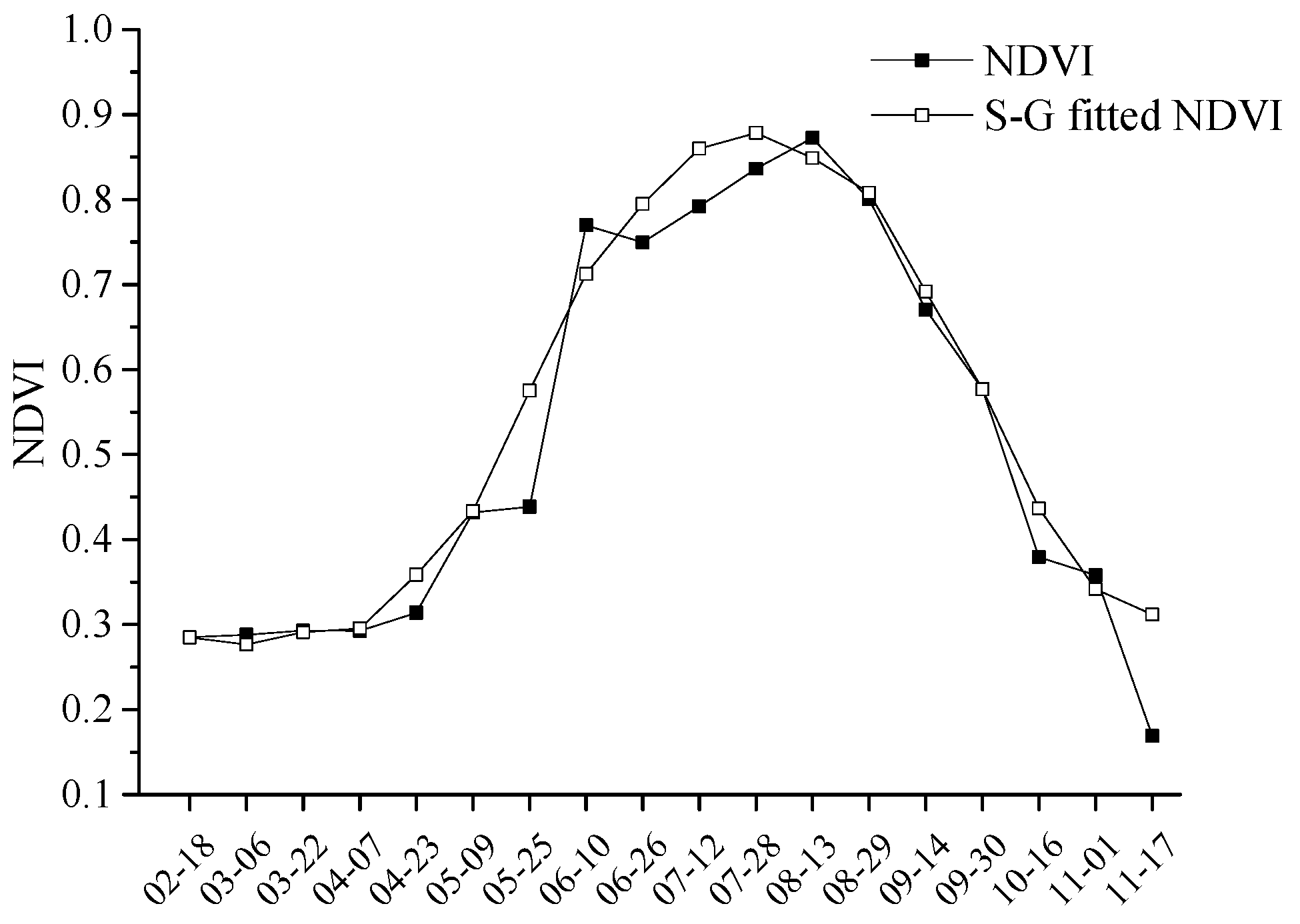
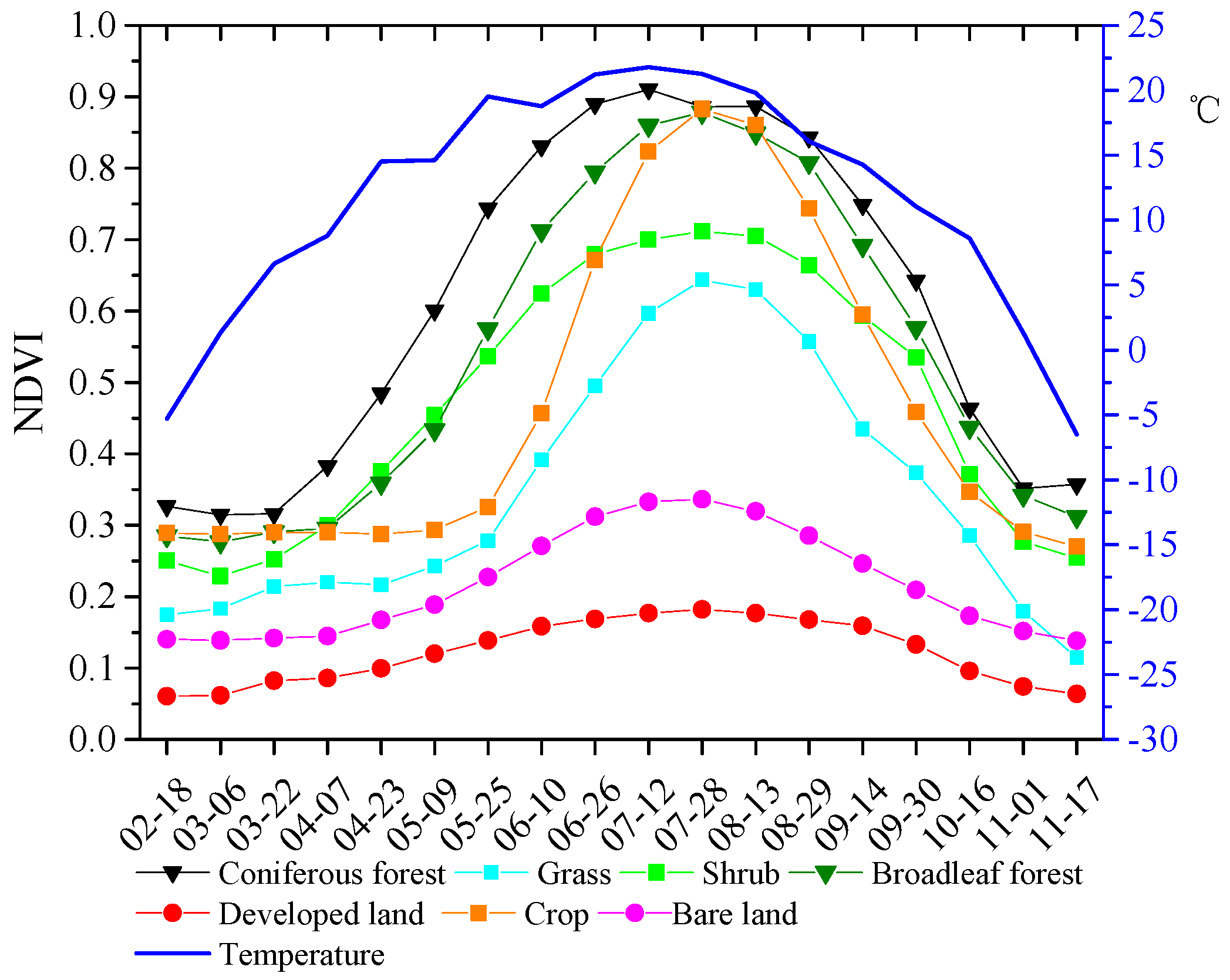
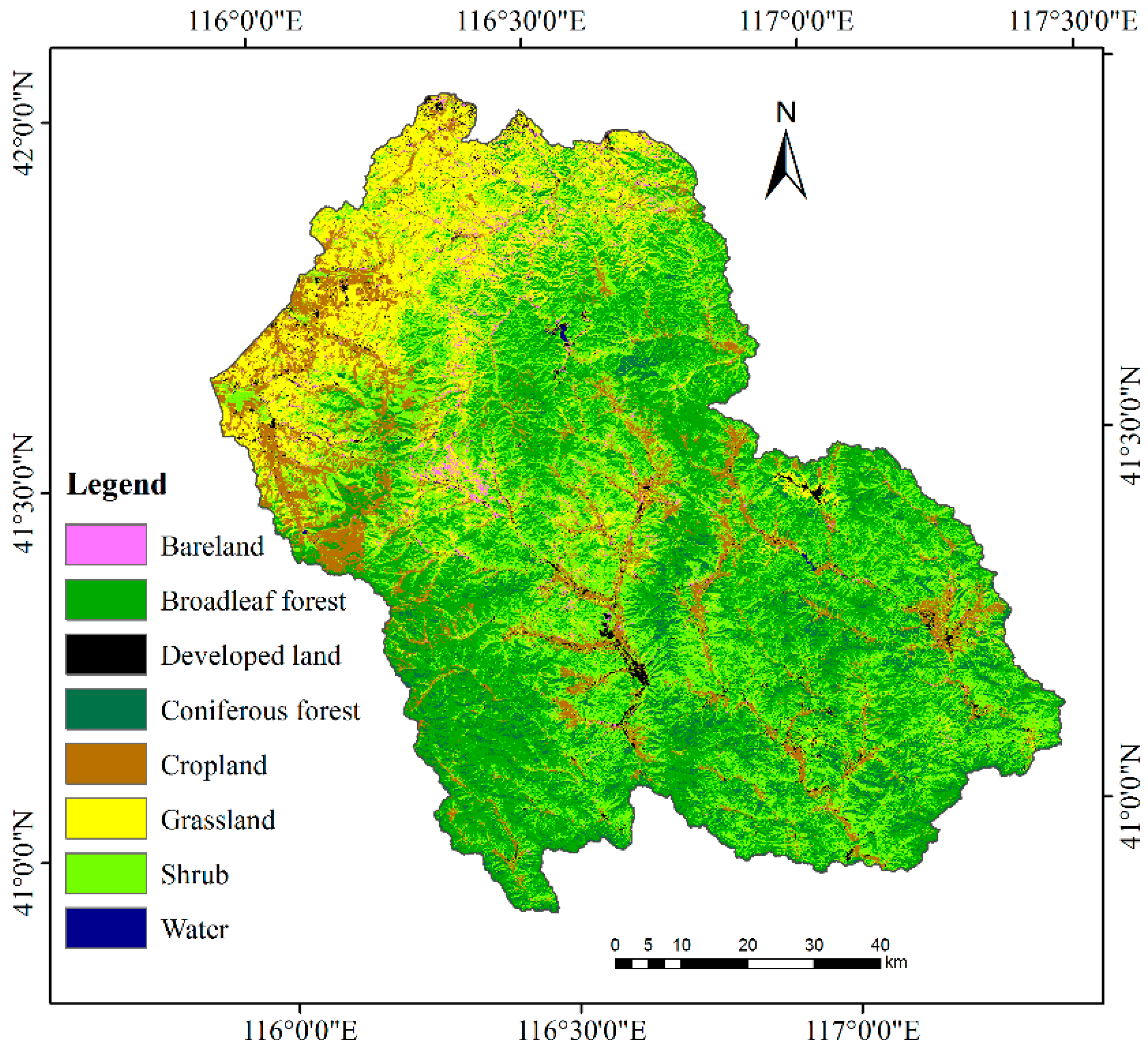
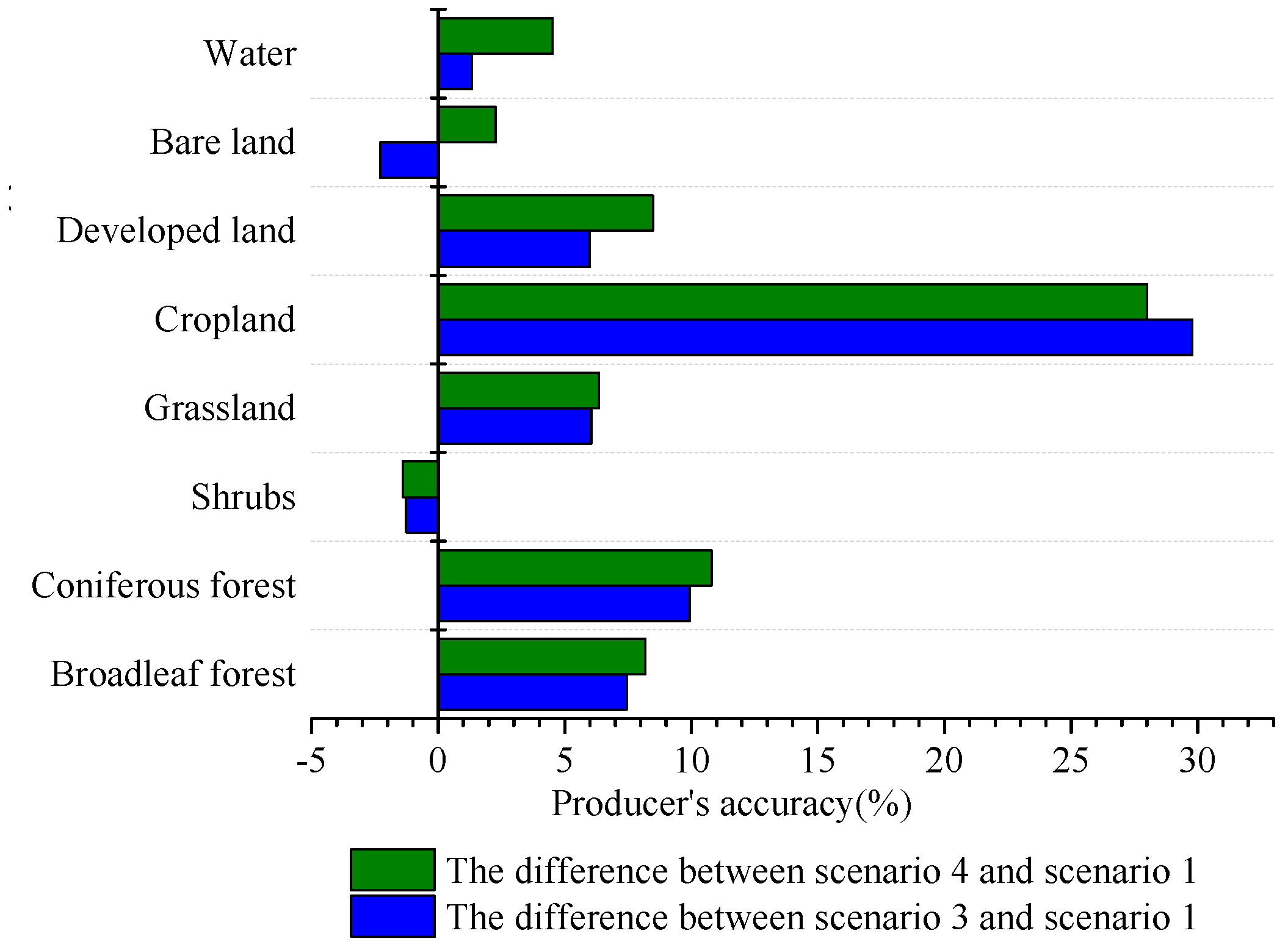
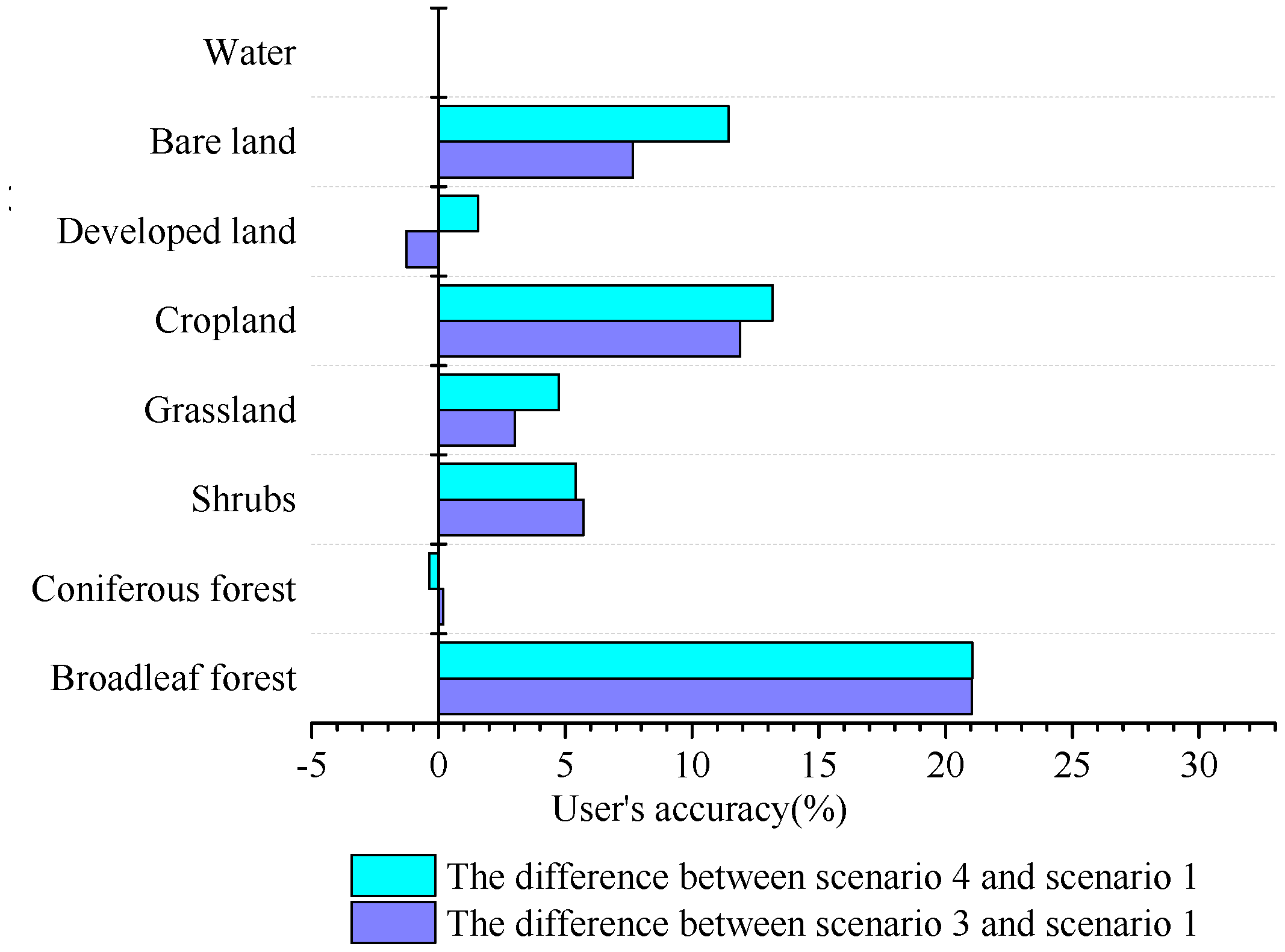
| GF-1 Data | MODIS Data | ||||||
|---|---|---|---|---|---|---|---|
| Sensors | Acquisition Date | Path/Row | Data Quality | Main Usage | Acquisition Date | Path/Row | Main Usage |
| WFV 1 | 15 August 2015 | 1/86 | No cloud | Fusion and classification | 18 February to 17 November 2015, total 18 images | h26v04 | Fusion of NDVI |
| WFV 1 | 25 May 2015 | 2/86 | Cloud cover: 2% | Validation | |||
| WFV 4 | 14 September 2015 | 2/85 | No cloud | Validation | |||
| Phenological Parameters | Definition |
|---|---|
| Start of the season (SOS) | Time for which the left edge has increased to 20% of the seasonal amplitude measured from the left minimum level |
| End of the season (EOS) | Time for which the right edge has decreased to 20% of the seasonal amplitude measured from the right minimum level |
| Length of the season (LOS) | EOS − SOS |
| Base value | Average of the minimum NDVI at the start of the growing season and the minimum NDVI at the end of the growing season |
| Mid-season date (MOS) | The mean of the dates when the left side of the NDVI curve has increased to 80% of the maximum NDVI and the right edge has decreased to 80% of the maximum NDVI |
| Maximum NDVI | The largest NDVI value in the fitted function for the growing season |
| Seasonal NDVI amplitude | The difference between the maximum NDVI and the base level |
| Scenario | 1 | 2 | 3 | 4 |
|---|---|---|---|---|
| Input datasets | GF-1 data | fused NDVI data | GF-1 data and fused NDVI | GF-1 data and phenological parameters |
| Number of bands | 4 | 18 | 22 (4 multi-spectral bands and 18 fused NDVI bands) | 11 (4 multi-spectral bands and 7 phenological parameters) |
| Data | 25 May 2015 | 14 September 2015 | ||
|---|---|---|---|---|
| Figure 3a | Figure 3b | Figure 3c | Figure 3d | |
| Mean value | 0.6505 | 0.6735 | 0.7200 | 0.6607 |
| Standard deviation | 0.1104 | 0.1189 | 0.1071 | 0.0941 |
| Mean difference | −0.0230 | 0.0593 | ||
| Correlation coefficient (Pearson’s r) | 0.87 | 0.78 | ||
| Vegetation Type | SOS (DOY) | EOS (DOY) | LOS (Days) | Base Value (NDVI) | MOS (DOY) | Maximum NDVI | Seasonal Amplitude (Change in NDVI) |
|---|---|---|---|---|---|---|---|
| Broadleaf forest | 118 | 315 | 197 | 0.2931 | 218 | 0.9066 | 0.6135 |
| Coniferous forest | 114 | 320 | 206 | 0.3299 | 215 | 0.8537 | 0.5238 |
| Shrubs | 121 | 316 | 195 | 0.2150 | 219 | 0.7629 | 0.5479 |
| Grassland | 140 | 308 | 168 | 0.1595 | 221 | 0.5668 | 0.4072 |
| Cropland | 154 | 301 | 147 | 0.2399 | 226 | 0.8603 | 0.6203 |
| Land Cover Type | Training Samples | Validation Samples | Scenario 1. GF-1 Data | Scenario 2. Fused NDVI Data | Scenario 3. GF-1 Data and Fused NDVI Data | Scenario 4. GF-1 Data and Phenological Parameters | ||||
|---|---|---|---|---|---|---|---|---|---|---|
| Producer’s Accuracy (%) | User’s Accuracy (%) | Producer’s Accuracy (%) | User’s Accuracy (%) | Producer’s Accuracy (%) | User’s Accuracy (%) | Producer’s Accuracy (%) | User’s Accuracy (%) | |||
| Broadleaf forest | 3006 | 2040 | 79.14 | 60.73 | 91.07 | 67.35 | 86.58 | 81.76 | 87.32 | 81.78 |
| Coniferous forest | 2064 | 1465 | 80.91 | 85.05 | 54.84 | 76.14 | 90.85 | 85.24 | 91.71 | 84.68 |
| Shrubs | 2266 | 1584 | 73.04 | 81.12 | 69.72 | 82.22 | 71.78 | 86.83 | 71.65 | 86.53 |
| Grassland | 2421 | 1610 | 85.47 | 86.19 | 83.37 | 76.22 | 91.51 | 89.21 | 91.81 | 90.94 |
| Cropland | 2780 | 1847 | 66.91 | 79.97 | 93.70 | 93.65 | 96.69 | 91.87 | 94.91 | 93.14 |
| Developed land | 2471 | 1657 | 74.73 | 92.65 | 69.74 | 74.09 | 80.72 | 91.38 | 83.22 | 94.21 |
| Bare land | 1325 | 917 | 94.33 | 69.76 | 58.12 | 58.19 | 92.04 | 77.43 | 96.62 | 81.21 |
| Water | 2002 | 1339 | 91.70 | 100.00 | 80.59 | 91.58 | 93.04 | 100 | 96.22 | 100 |
| Total | 18,335 | 12,459 | ||||||||
| Overall accuracy (%) | 79.51 | 77.30 | 87.85 | 88.83 | ||||||
| Kappa coefficient | 0.7641 (p-value < 0.001) | 0.7379 (p-value < 0.001) | 0.8602 (p-value < 0.001) | 0.8714 (p-value < 0.001) | ||||||
© 2016 by the authors; licensee MDPI, Basel, Switzerland. This article is an open access article distributed under the terms and conditions of the Creative Commons Attribution (CC-BY) license (http://creativecommons.org/licenses/by/4.0/).
Share and Cite
Kong, F.; Li, X.; Wang, H.; Xie, D.; Li, X.; Bai, Y. Land Cover Classification Based on Fused Data from GF-1 and MODIS NDVI Time Series. Remote Sens. 2016, 8, 741. https://doi.org/10.3390/rs8090741
Kong F, Li X, Wang H, Xie D, Li X, Bai Y. Land Cover Classification Based on Fused Data from GF-1 and MODIS NDVI Time Series. Remote Sensing. 2016; 8(9):741. https://doi.org/10.3390/rs8090741
Chicago/Turabian StyleKong, Fanjie, Xiaobing Li, Hong Wang, Dengfeng Xie, Xiang Li, and Yunxiao Bai. 2016. "Land Cover Classification Based on Fused Data from GF-1 and MODIS NDVI Time Series" Remote Sensing 8, no. 9: 741. https://doi.org/10.3390/rs8090741





